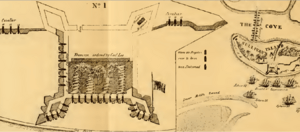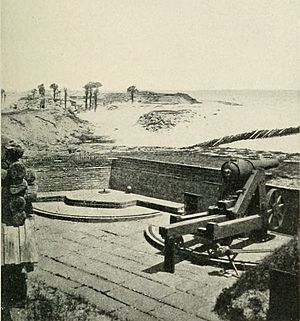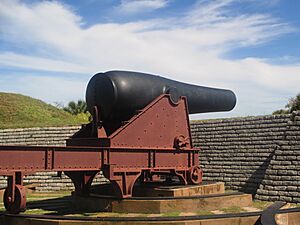Fort Moultrie facts for kids
Quick facts for kids Fort Moultrie |
|
|---|---|
| Part of Fort Sumter and Fort Moultrie National Historical Park | |
| Sullivan's Island, South Carolina, U.S. | |

Fort Moultrie in December 2006. The United States flag is at half-staff because of Gerald R. Ford's death.
|
|
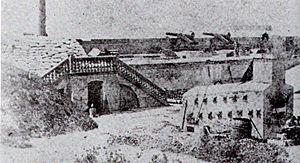
Fort Moultrie in 1861.
|
|
| Coordinates | 32°45′33.81″N 79°51′28.05″W / 32.7593917°N 79.8577917°W |
| Site information | |
| Owner | National Park Service |
| Open to the public |
Yes |
| Site history | |
| Built | 1776 |
| In use | 1776–1947 |
| Battles/wars | Battle of Sullivan's Island |
Fort Moultrie is a historic fort located on Sullivan's Island, South Carolina. It was built to protect the important city of Charleston. The very first fort here was called Fort Sullivan. It was made from strong palmetto logs. These logs were so good at stopping cannonballs that they inspired the flag and nickname of South Carolina, "The Palmetto State". The fort was later renamed to honor General William Moultrie. He was a brave American commander in the Battle of Sullivan's Island. When the British took over, they called it Fort Arbuthnot for a short time.
Contents
History of Fort Moultrie
Building the First Fort
In 1776, American patriots started building a fort to guard Charleston's harbor. Colonel William Moultrie took charge of Sullivan's Island on March 2, 1776. His team included 413 soldiers and 22 artillerymen. The fort was still being built at the southern tip of the island. It was designed to be square with strong corner sections called bastions. The walls were supposed to be made of palmetto logs, about 10 feet high, filled with 16 feet of sand.
However, by June 28, only the front walls were finished. The northern part of the fort was only about 7 feet tall. A blue flag with the word "Liberty" flew from one of the bastions. Thirty-one cannons were ready to defend the harbor entrance.
The Battle of Sullivan's Island
On June 28, 1776, during the American Revolutionary War, a British fleet attacked the unfinished Fort Sullivan. Admiral Sir Peter Parker led nine warships. But the soft palmetto logs of the fort were amazing! Instead of breaking, they absorbed the cannonballs. Some reports even say cannonballs bounced right off the walls.
William Moultrie and his 400 men fought all day. Parker's fleet was badly damaged and had to leave. Because of this victory, the fort was renamed Fort Moultrie in his honor. People in Charleston still celebrate "Carolina Day" to remember the brave defenders.
During this battle, Moultrie used a special flag he designed. It was later called the Moultrie flag or Liberty flag. It became a symbol of the Revolution in the South. The British did capture Fort Moultrie in 1780 during the Siege of Charleston. They renamed it Fort Arbuthnot. But the Americans won the war, and the British left in 1782.
Fort Moultrie in the Early 1800s
After the American Revolution, the United States worried about new wars in Europe. So, they built many forts to protect important harbors. A new Fort Moultrie was finished in 1798 on top of the old one. But in 1804, a huge hurricane destroyed it.
The fort was rebuilt again between 1808 and 1809. This time, it was made of brick and had 40 guns. It could house 500 soldiers. For the next 50 years, Fort Moultrie's main design stayed mostly the same. However, a new fort, Fort Sumter, became the main defense for Charleston.
Fort Moultrie also served as a prison for Native American captives. In 1837, the famous Seminole leader Osceola was held there. He died in January 1838 and was buried at the fort's front gate. His grave is still there today.
Fort Moultrie During the Civil War
Before the American Civil War, tensions were very high. South Carolina decided to leave the Union on December 20, 1860. This happened after Abraham Lincoln was elected president.
The U.S. Army soldiers at Fort Moultrie did not surrender to South Carolina forces. On December 26, 1860, Union Major Robert Anderson moved his soldiers from Fort Moultrie to the stronger Fort Sumter. In April 1861, Confederate troops attacked Fort Sumter, starting the Civil War.
In April 1863, Union ships and shore batteries began attacking Fort Moultrie and other forts around Charleston. For 20 months, the Union forces bombarded the forts. Fort Sumter was turned into a pile of rubble. Fort Moultrie was covered by a sand hill, which protected it from the constant shelling. The Confederate soldiers bravely stayed at Fort Moultrie. But in February 1865, as General Sherman's army marched through South Carolina, they finally left the fort and Charleston.
Modernizing Fort Moultrie
After the Civil War, the U.S. Army updated Fort Moultrie in the 1870s. They added new weapons and strong concrete bunkers. These included large 15-inch and 10-inch cannons.
Starting in 1897, the fort was modernized even more as part of a big defense plan. Eight new concrete batteries were built by 1906. Some parts of the old fort were removed to make space for these new batteries. The fort also had a special room to control a field of naval mines in the harbor.
The largest new battery, called Capron-Butler, had sixteen 12-inch mortars. Other batteries had powerful 10-inch and 6-inch guns that could disappear into their protective covers after firing. These new defenses were very important during the Spanish–American War and World War I.
When World War II began in 1939, the fort was upgraded again. New, powerful 12-inch guns were installed. These new long-range guns made most of the older defenses around Charleston useless. Many of Fort Moultrie's older weapons were removed in 1942.
On August 15, 1947, the Army officially closed Fort Moultrie. After 171 years of service, it was no longer needed. New military technology, like submarines and nuclear weapons, meant that defending the coast with forts was no longer the best strategy.
Fort Moultrie Today
|
Fort Moultrie Quartermaster and Support Facilities Historic District
|
|
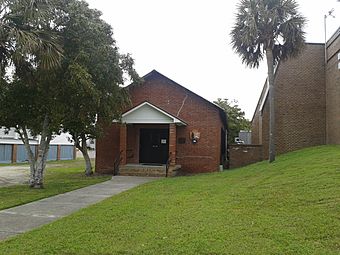
The former torpedo (naval mine) storage building at Fort Moultrie; today it serves as office space for the park.
|
|
| Lua error in Module:Location_map at line 420: attempt to index field 'wikibase' (a nil value). | |
| Location | Middle St. and Thompson Ave., bet. Stations 14 and 16.5, Sullivan's Island, South Carolina |
|---|---|
| Area | 5.3 acres (2.1 ha) |
| MPS | Sullivan's Island, South Island MPS |
| NRHP reference No. | 07000925 |
| Added to NRHP | September 6, 2007 |
In 1960, the U.S. government gave Fort Moultrie to the National Park Service. Today, it is part of the Fort Sumter and Fort Moultrie National Historical Park. Visitors can explore the fort and see how it changed over time. You can see defenses from World War II all the way back to the original palmetto log fort.
The fort is also recognized as a historic place. In 2016, Fort Moultrie was featured on an America the Beautiful quarter.
General William Moultrie is honored with a statue in The Battery in downtown Charleston.
See also
- 13th Coast Artillery (United States)


